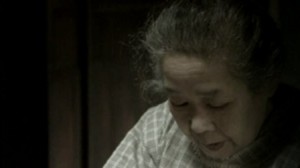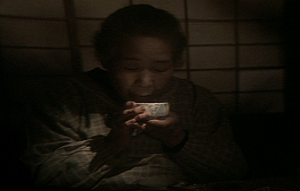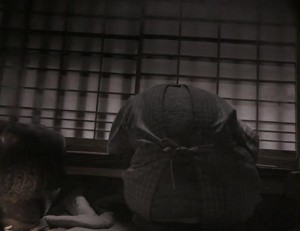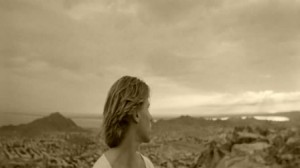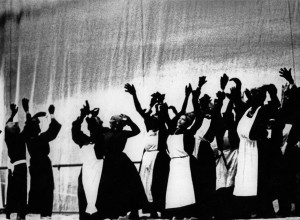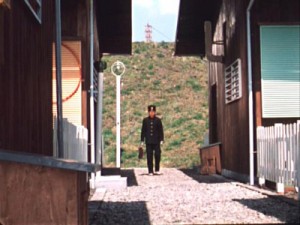From the Chicago Reader (March 3, 2000):
A Humble Life
Rating ** Worth seeing
Directed and written by Alexander Sokurov.
I’ve seen at least a dozen of Alexander Sokurov’s works, but I’ve had a rough time getting a clear fix on him. For one thing, I didn’t recall having seen either A Lonely Man’s Voice (1978), his first feature, or The Second Circle (1990), yet when I checked I found I’d written reviews of both a decade ago. Is my brain a sieve? Or is it that many of Sokurov’s works are like passing mists on the verge of evaporating? Like his late mentor Andrei Tarkovsky, Sokurov is a mystical master of indeterminate zones — sometimes making it impossible to determine whether a shot is in color or black-and-white, whether it’s showing an interior or exterior, and whether it represents inner or external realities. So much uncertainty can make a film hard to remember.
For another thing, Sokurov is extremely prolific as both a filmmaker and a video artist — the only filmography I have available, dating from early 1991, includes 20 items — yet much of his career remains undocumented. According to film historian Nicholas Galichenko, Sokurov isn’t even mentioned in the 1987 Soviet film encyclopedia Kino, even though — or is it because? — “Tarkovsky anointed him as his heir.” According to Sokurov, he made two full-length features, “several short features,” and half a dozen documentaries in Russia between 1980 and 1987, all of which were banned by Soviet censors, though some of them surfaced after glasnost — much worse treatment than Tarkovsky got.
Most or all of Sokurov’s work since has been made in either Germany or Japan. (To the best of my knowledge, Japan is the only country where several of Sokurov’s films are available on video.) The language of this work is usually Russian — with the exception of Moloch (1999), which chronicles a day in the life of Adolf Hitler and Eva Braun — and the English translations are often so slipshod that they only confuse matters. Take for example the distributor’s press handout for A Humble Life (1997) — a feature-length video being shown this Friday at Columbia College by Chicago Filmmakers — which states, “Sokurov invites us on a journey through time and space. A journey through space first. At the beginning of the 21st century he takes us to a Japan divorced from time: we meet a woman embroiderer of kimonos perpetuating an age-old art. In a sturdy building in the heart of the country at the foot of a range of mountains bathed in winter fog, the filmmaker shows us a day in the life of this woman. Exchanges are reduced to a minimum: a few haikus read in the evening.”
Most of this is quite clear, but the phrase “at the beginning of the 21st century” — which leads us to expect some sort of science fiction, since the video was made in 1997 — is off. The French translation of this passage uses aube (dawn), the German Schwelle (threshold). So which is it? And the English subtitles or intertitles are often distractingly awkward; for instance, the final intertitle of A Humble Life, identifying who and what we’ve just seen, reads: “Umeno Mathuyoshi / The Mistress of the old house in mountains / village Aska / prefecture Nara / Japan.”
All of Sokurov’s films and videos that I’ve seen aim for a 19th-century mood and setting, tend to make spaces flat and foreshortened (though densely textured), have minimal narratives and restricted subject matter, and are at least as slow as molasses in January. (It’s often the triumph of his works that all these traits seem interdependent.) Most of his films are shot in 35-millimeter and are usually fictional or semifictional narratives; the videos are mainly documentaries, though Sokurov aptly calls a good many of them “elegies.” But such descriptions oversimplify matters. The films, by virtue of their slowness, ultimately resemble documentaries of their actors and their settings, and at least some of the videos, including A Humble Life, by virtue of their poetic and personal offscreen narrations, resemble fictional narratives.
Susan Sontag recently listed her ten favorite films of the 90s in Artforum, including two Sokurov features, The Second Circle and The Stone (1992). “There’s no director active today whose films I admire as much,” she writes, citing The Days of Eclipse (1988) [see below] as his greatest film. Some of my overseas colleagues dismiss the features but embrace the videos.
The slowness and general absence of narrative progression in Sokurov’s work clearly drives some viewers around the bend, but I find these things fascinating, in part because they force me to examine my usual viewing habits. Indeed, the slowness of a Sokurov work is often so extreme that time almost seems to be converted into space, experienced as the state of remaining indefinitely in one particular place. (“In everything there is persistence, obstinancy and immutability,” says the narrator of A Humble Life, sounding rather like William Faulkner, as the camera crawls up the walls of an ancient Japanese house.) I experienced the same effect when I first encountered No theater, in Kyoto, where a medieval play that originally took 45 minutes to perform now lasts three times as long because of the distended mise en scene. (The only near equivalents I’ve seen in Western theater are Robert Wilson’s Deafman Glance [see below] and Samuel Beckett’s direction of his own one-act Footfalls, both in the mid-1970s.)
That Sokurov now does most of his production in Germany and Japan hardly seems accidental, for they, along with Russia, have generally made the slowest films — though the ways in which they’re slow are quite different. To oversimplify matters scandalously, Russian films tend to be slow and ponderous, German films slow and heavy (at least during the silent period), and Japanese films slow and fast and light.
To explain how Japanese films can be both slow and fast, let me cite “Ceremonial Japan,” a provocative short essay by avant-garde composer Karlheinz Stockhausen written a quarter of a century ago. Exploring his fascination with a diverse variety of Japanese ceremonial forms — including No theater, Sumo wrestling, and the tea ceremony — Stockhausen states, “Where timing is concerned, the European is absolutely mediocre. Which means he has settled down somewhere in the middle of his range of potential tempi. It is a very narrow range, compared with the extremely fast reactions that a Japanese [person] might have at a certain moment, and to the extremely slow reaction that he might show on another occasion. He has a poor middle range compared to the European.”
As support for Stockhausen’s hypothesis, I would cite much of the action in Yasujiro Ozu’s Tokyo Story, where the main characters are fairly old and usually seated, as extremely slow. Yet there are some pretty fast actions and reactions in his silent films, where the characters are relatively young and are usually seen standing or walking. And in Good Morning, where standing kids and seated adults are equally prominent, we get intricate mixtures of fast and slow tempi. (For extremely fast action, check out Akira Kurosawa’s Yojimbo or The Seven Samurai.) By these standards, A Humble Life, whose subject is fairly old and most often seated, is closest to Tokyo Story — though it’s considerably slower.
A Humble Life begins rather like a gothic novel (as does the more seductive and magical, mainly black-and-white Sokurov video Oriental Elegy, from 1996). Shot mainly in color, it opens with a candle burning in a domestic setting and a rhythmically clacking trainlike sound that recalls the last shot of Tarkovsky’s Stalker. An unidentified, basically unseen male narrator — presumably Sokurov — vaguely describes his arrival at an old house in the mountains at twilight, then we see a gas lamp on the floor beside his bedding, which is stroked by fingers in close-up.
A series of black-and-white photos of babies and “somebody’s mother” appear in the narrator’s mind “from the past or future” — in an apparently rural Russian setting that characterizes the narrator’s background — and then the camera begins to explore the 130-year-old Japanese house in the mountains and the old woman who lives there, “who seemed not to notice me.” There are occasional interpolations of clouds, forest, stream, and adjoining rock garden. The old woman’s face and her house and sewing are serenely contemplated in close-ups and long shots, in slow lap dissolves and camera movements.
Nothing much more happens. Chanting Buddhist monks with bells turn up briefly outside the house, receive alms from the woman, and go away. A passing motorbike is heard. The woman eats and prays. The narrator decides it’s time to leave and waits for the woman in the house’s main room. After a reprise of the video’s opening shot, she appears and reads aloud several of her haikus, which allude to nature, her late husband, her married daughter, a coming snowstorm. (They’re translated in titles that balance the composition of the images — as sometimes happens in Japanese films — appearing first in the upper right corner of the frame and then, over a closer shot of the woman, in the upper left corner.) Then, in an extended shot, she bows and leaves the frame, and there’s a slow fade-out of the empty space.

